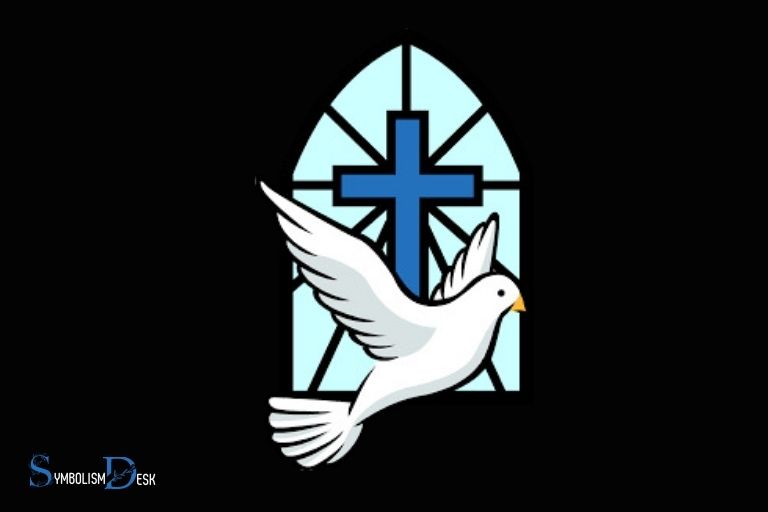Symbols of Confirmation And What They Mean? Dove!
Confirmation symbols, represented in various forms such as the cross, dove, oil, and laying on of hands, are significant expressions of the sacrament of Confirmation in the Christian tradition.
Each emblem underscores a profound aspect of this religious rite, signifying the Holy Spirit’s presence, divine acceptance, spiritual strength and unity with the church community.
Confirmation in Christianity is one of the seven sacraments that are considered essential for the spiritual journey of a believer. This sacrament is associated with several symbols, each with a specific connotation.
The cross symbolizes sacrifice and redemption; the dove represents the Holy Spirit; oil, often referred to as Chrism, is a sign of anointing, and the laying on of hands denotes a blessing and the impartation of the Holy Spirit.
The symbols used in the sacrament of Confirmation imbue this spiritual milestone with profound significance.
8 Symbols of Confirmation and Their Meanings
| Symbol | Meaning |
|---|---|
| Dove | Representative of the Holy Spirit and symbolizes peace and purity. |
| Sponsor | An adult who represents the candidate, symbolizing responsibility and spiritual guidance. |
| Bishop | The official who usually carries out confirmation, symbolizes apostolic succession. |
| Chrism | Sacred oil used in the ceremony, symbolizes strengthening and the gifts of the Holy Spirit. |
| Laying on of hands | An act that symbolizes the descent of the Holy Spirit. |
| Sign of the Cross | Symbolizes the death and resurrection of Jesus Christ. |
| White Garment | Representative of purity and new life in Christ. |
| Candle | Symbolizes Jesus as the light of the world. |
Key Takeaway

Five Facts About: Symbols of Confirmation and Their Meanings
Defining Confirmation Symbols
Symbols are an integral part of confirmation ceremonies in christianity. These symbols are used to represent various aspects of the faith and hold significant meaning for those being confirmed.
In this particular section, we will specifically be defining confirmation symbols. Let’s get started!
Explanation Of Symbols
Confirmation symbols are physical representations of invisible spiritual concepts. They are designed to help those being confirmed relate to and understand the religious teachings.
These symbols are usually chosen for their deep and rich theological meanings, which are meant to enhance the religious experience of those being confirmed.
Role Of Symbols In Confirmation Ceremonies
Symbols play a crucial role in confirmation ceremonies. They are used to convey spiritual concepts to the person being confirmed, who may struggle to understand or relate to abstract ideas.
Through the use of symbols, the person being confirmed can experience a deeper connection to their faith, which can lead to a greater understanding and acceptance of religious teachings.
Examples Of Symbols Used In Confirmation Ceremonies
Confirmation ceremonies use a variety of symbols to represent different religious concepts.
Here are some examples:
- The holy spirit is often represented by a dove symbol. This references the biblical story of jesus’ baptism, where the holy spirit descended onto him in a form of a dove.
- Oil is also a common confirmation symbol. It is used to represent the holy spirit, and the anointing of the person being confirmed.
- The cross is a powerful symbol in christianity and often used in confirmation ceremonies. It represents the sacrifice that jesus christ made when he died on the cross for the sins of humanity.
- Water is also a symbol used in confirmation ceremonies. It represents baptism, and the cleansing of sins.
Confirmation symbols are integral parts of the confirmation ceremony and are used to convey religious concepts to those being confirmed.
They have rich theological meanings and can enhance the religious experience of those they are meant to represent.
Symbolism In Confirmation Ceremonies
Symbols Of Confirmation And What They Mean
In christianity, confirmation is a sacrament celebrated by various denominations. It is a rite of passage that signifies the strengthening of a deep connection between an individual and the faith.
As with many other religious ceremonies, confirmation involves the use of symbols to represent various aspects of the faith.
In the following subheading, we will explore the significance of symbols in confirmation ceremonies, how they deepen meaning, and their connection to faith.
Significance Of Symbols In Confirmation Ceremonies
In confirmation ceremonies, symbols are used to represent the faith, its teachings, and the individual’s dedication to following them.
These symbols serve as physical manifestations of the spiritual beliefs of the faith, and they bear different meanings that resonate with the participants of the ceremony.
Some of the most common symbols used in confirmation ceremonies include:
- Anointing with oil, which signifies strength, dedication, and consecration.
- Laying on of hands, which signifies blessings, empowerment, and impartation of the holy spirit.
- The sign of the cross, which signifies faith, devotion, and redemption.
- The dove, which signifies the holy spirit, peace, and purity.
How Symbols Deepen Meaning In Confirmation
Symbols are powerful tools for communicating meanings that cannot be expressed in words. In confirmation ceremonies, symbols communicate the profundity of the faith and its teachings in a way that is tangible and relatable to the participants.
Symbols provide a visual representation of the intangible and a reminder of the spiritual truths that the faith seeks to uphold.
Symbols also evoke emotions and help to create a sense of connectedness between the participants, the faith, and the divine.
Connection Between Symbols And Faith
Symbols are an integral part of faith and spirituality. They help to illustrate the abstract and provide a foundation for beliefs, values, and teachings.
In confirmation ceremonies, symbols are a physical representation of the faith and its teachings. They help to deepen the participant’s understanding of the faith and their connection to it.
Through symbols, individuals can express their devotion and dedication to living a life that is consistent with the values and teachings of the faith.
Symbols are powerful tools used in confirmation ceremonies to signify the faith’s teachings, dedication, and consecration.
They are a visual representation of the intangible and help to deepen the participant’s understanding of the faith and their connection to it.
Through symbols, individuals can express their devotion and dedication to living a life that is consistent with the values and teachings of the faith.
Meanings Of Confirmation Symbols
Symbols Of Confirmation And What They Mean
Confirmation, an important sacrament celebrated in christian churches, is associated with many symbols.
These symbols carry powerful meanings that help christians understand the significance of their faith and guide them on their spiritual journey.
The Cross As A Symbol Of Faith
The cross is an iconic symbol of christianity, representing the ultimate sacrifice made by jesus christ on the cross for human salvation. In confirmation, the cross is a symbol of faith and commitment.
The key points about the cross are:
- It represents the love of god, who sacrificed his own son for humanity.
- It serves as a reminder of the sacrifice that jesus made for humanity, which also symbolizes redemption and salvation.
- It marks the beginning of a lifelong journey of faith, love, and discipleship.
The Holy Spirit As A Symbol Of Strength And Guidance
The holy spirit is another symbol associated with confirmation. It is often depicted as a dove, which represents purity, peace, and the presence of god. The holy spirit is considered to be the source of salvation, strength, and guidance for christians.
The key points about the holy spirit are:
- It is an integral part of the holy trinity, representing god’s presence in the world and in our lives.
- It provides strength and support in times of need, by guiding individuals to make wise choices.
- It is a symbol of the consecration process, which signifies a deepening of faith and spiritual growth.
The Dove As A Symbol Of Purity And Peace
The dove, as mentioned earlier, is an important symbol of the holy spirit. It represents peace, purity, and hope. The dove is also a symbol of the new beginning, the new chapter in one’s journey of faith.
The key points about the dove are:
- It represents the presence of the holy spirit and the grace of god.
- It symbolizes purity, peace, and hope for a new beginning. It is the “olive branch” of modern times.
- It is a representation of god’s love, which is why it is also an essential symbol of confirmation.
The Oil As A Symbol Of Healing And Anointing
Another essential symbol of confirmation is the oil, which is used to anoint individuals who are being confirmed. This anointing is symbolic of healing and the holy spirit’s presence.
The key points for the oil are:
- The oil symbolizes spiritual strength and courage for individuals receiving confirmation.
- The anointing with oil represents a spiritual cleansing and a renewal of faith.
- It is a physical representation of the holy spirit’s presence in the individual’s life.
The Flame As A Symbol Of Passion And Zeal
Finally, the flame is also an essential symbol of confirmation. The flame represents passion, zeal, and enthusiasm for one’s faith. During confirmation, the individual receives the gift of the holy spirit, which is considered a flame of love.
The key points about the flame are:
- It symbolizes the presence of the holy spirit and the individual’s passion for their faith.
- The flame represents the fire of faith, which inspires individuals to grow spiritually and spread the teachings of christ.
- It is a reminder of the spiritual treasures that individuals receive during confirmation.
The symbols of confirmation carry significant meanings, as outlined above. These symbols guide christians on their spiritual journey, helping them grow in faith and understanding.
Interpreting Symbols In Confirmation Ceremonies
Symbols Of Confirmation And What They Mean
Confirmation not only signifies the individual’s initiation into their religion but also represents their acceptance of their faith. The confirmation ceremony is a significant and meaningful occasion in which symbols play an integral part.
Interpreting the symbols used during confirmation ceremonies can enhance the ceremony’s importance and help the candidate connect with their spirituality on a more profound level. Let us explore the different ways by which confirmation symbols are interpreted.
How Confirmation Symbols Are Interpreted By Different Faiths
People of various religions use different symbols to represent confirmation.
Here are some examples:
- Catholics use the cross, holy oil, and white garment to symbolize the candidate’s commitment to christ.
- Protestants use a dove or a descending flame to represent the holy spirit as a sign of confirmation.
- Orthodox christians use holy water, oils, and a lighted candle to symbolize christ’s personification.
The Relationship Between The Symbols And The Confirmation Candidates
Confirmation symbols hold a deep connection to the candidate and their faith. The symbols represent the individual’s spiritual journey and their initiation into their religion.
During the ceremony, the candidate is anointed with holy oil, given a white garment and candle, and offered the sign of peace.
Each symbol carries a unique meaning, which helps the candidate connect with their spirituality on a more profound level and feel closer to god.
Steps To Interpret Confirmation Symbols During The Ceremony
Interpreting confirmation symbols during the ceremony can help the candidate connect with their faith and understand the significance of each symbol.
Here are the steps to interpreting confirmation symbols:
- The candidate is anointed with holy oil, which symbolizes the holy spirit’s protection and grace. They may also receive a gift of the holy spirit, represented by a dove.
- The white garment symbolizes purity and is a sign that the candidate has put on christ. It reminds the candidate that they are a new creation and should strive to live a life worthy of their faith.
- The lit candle represents the light of christ, which the candidate should carry with them always. It reminds the candidate that they are called to be the light of the world and share their faith with others.
- The sign of peace signifies the unity and mutual love shared by all catholics. It also symbolizes the forgiveness of sins and a fresh start in life.
Interpreting confirmation symbols is a crucial part of the ceremony, which can help the candidate connect with their faith on a personal and spiritual level.
The symbols used vary from religion to religion, but their purpose remains the same- to signify the candidate’s commitment to their faith and mark the beginning of their spiritual journey.
FAQ About Symbols Of Confirmation And What They Mean
What Is Confirmation?
Confirmation is a sacrament of initiation in the catholic church where believers receive the holy spirit.
What Are The Symbols Used During Confirmation?
Some common symbols are the holy chrism, the laying on of hands, the sign of peace.
What Does Holy Chrism Signify During Confirmation?
Holy chrism is a mixture of oil and balsam that signifies the anointing of the holy spirit.
What Is The Laying On Of Hands During Confirmation?
The laying on of hands is when the bishop places his hands on the head of the person being confirmed.
What Is The Significance Of The Sign Of Peace During Confirmation?
The sign of peace signifies the unity of the faithful in the church and the peace of christ.
Conclusion
As we’ve explored, symbols play an important role in the catholic sacrament of confirmation, representing a range of meanings and messages.
From the oil used to anoint the forehead to the use of water and fire, each symbol holds significance and helps to bring deeper understanding to the spiritual journey being undertaken.
It’s important to remember that these symbols are not simply gestures or decorations – they are powerful reminders of the strength and faith required to be confirmed in the catholic church.
Whether it’s the image of a dove or the sound of a bell, each symbol has the ability to connect us to something greater and instill a sense of awe and reverence. Whether it’s the image of a dove or the sound of a bell, each symbol has the ability to connect us to something greater and instill a sense of awe and reverence. Symbols carry layers of meaning that transcend language, speaking directly to our shared experiences and cultural heritage. For instance, the meaning of the landing eagle symbol often evokes strength, freedom, and a profound connection to the natural world, reminding us of the values we hold dear and the aspirations we strive for as individuals and communities.
As we reflect on these powerful signs, let us remember the significance of the confirmation sacrament and the lifelong journey of faith that it represents.






